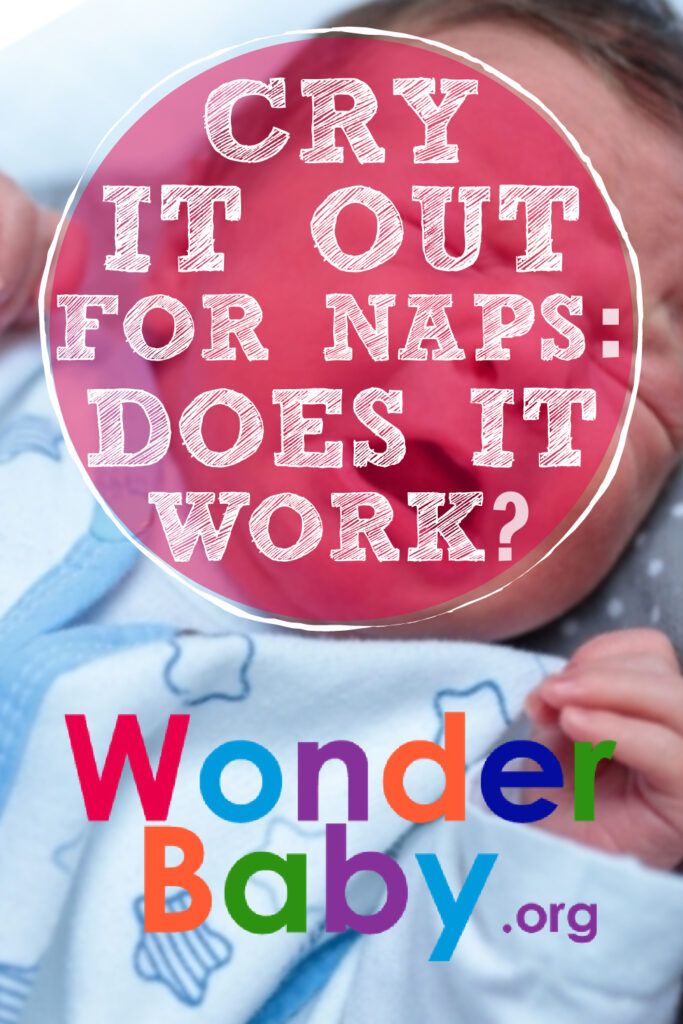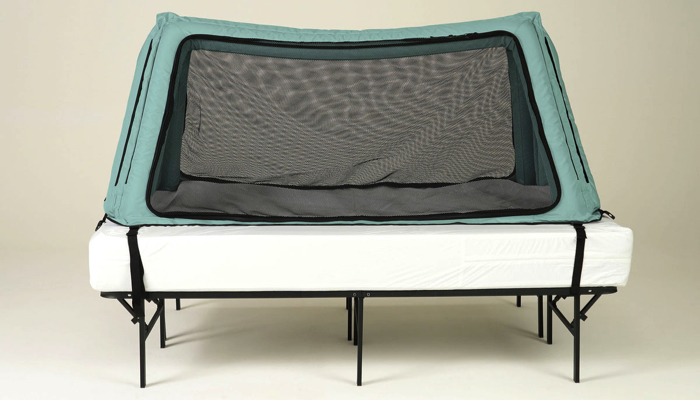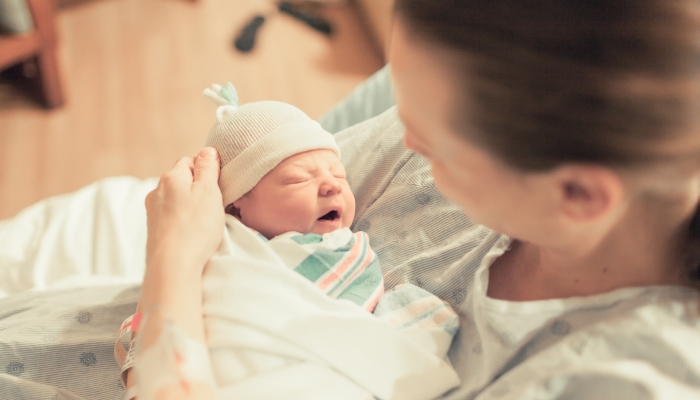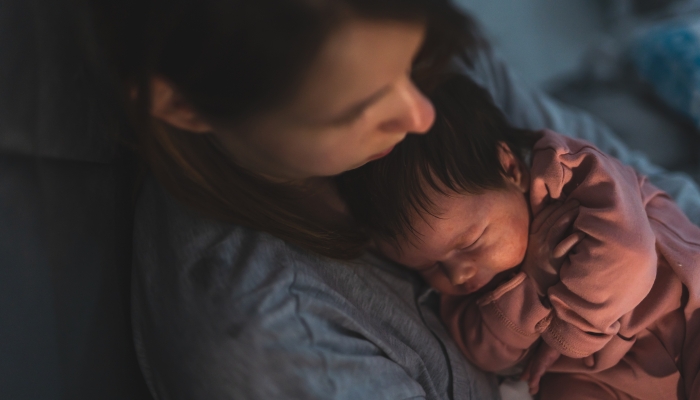Cry It Out for Naps: Does it Work?

- The cry it out method is a sleep training method in which you teach your baby to self-soothe and put themselves to sleep.
- Parents who use the cry it out method for naps will have more success if it’s done in conjunction with nighttime sleep training as well.
- A 2022 study by Blunden, et al found that there was no significant increase in cortisol in the babies using cry it out versus other sleep training methods.
Imagine you lay your little one down for a nap. This is your one hour of freedom—two if you’re lucky.
It’s the time you’ve been waiting for all day. The time when you get to eat that last piece of chocolate cake and read that book you’ve had on your kitchen counter for two weeks.
But just as you sit down and lift the first bite of chocolate cake to your lips, your little one lets out a shrill cry for mom. You know this is just the beginning of the nap time battle. It’s likely that the book will go unread one day longer.
When babies and toddlers have difficulty falling asleep for naptime it can be challenging. The same is true for little ones who fall asleep and then wake shortly after, unable to go back to sleep on their own.
Daytime naps are crucial for not just mom’s sanity but also baby’s wellbeing. So how do you effectively solve your child’s sleep problems?
Various sleep training methods exist to help your baby sleep more soundly. The cry it out method is one of these and is usually very successful with parents who try it.
Are you wondering if letting your baby cry it out for naps even works? Or if it’s just cruel and unnecessary? We’re here to educate you so you can make the right decision for your family.
What Is the Cry It Out Method?
The cry it out sleep training method is no new name in the sleep training method world. Among all the sleep training methods, this might be the most well-known and controversial.
The cry it out method is a sleep training method in which you teach babies to self-soothe and put themselves to sleep. For parents of children who have become reliant on them to go to sleep, it’s often the go-to method when you’ve exhausted all others.
With this method, you essentially let your baby cry themselves to sleep after reassuring them of their safety and your love for them. The goal is for the crying to lessen drastically each night until your baby cries for only a few minutes to none. For most babies, this happens within the first week of sleep training.
No one likes letting their baby cry, but the cry it out method isn’t as harsh as it sounds. Parents can go in and remind their babies that they are still there, as in the Ferber method, without derailing the process. The reward of helping your baby fall asleep independently is worth the sacrifice.
Does Crying It Out for Naps Work?
In short, yes cry it out does work for naps. However, parents who use the cry it out method will have more success if it’s done in conjunction with nighttime sleep training as well. This will keep sleeping routines consistent across the board.
You should also know that babies fall asleep easily at night because of the extra melatonin their bodies produce. The sleep training process for nap time will likely look different. You may have to let your child cry a little longer and they may not fall asleep as quickly.
How Long Should I Let My Baby Cry?
This might be the biggest question on the minds of parents when they start sleep training using cry it out. After all, no parent enjoys hearing their child cry. If only there were a simple answer for this.
Generally speaking, a 30 to 60-minute crying window is a good range. Anything longer may become unbearable for the parent and too exhausting for the child. Anything shorter might not give them an adequate amount of time to fall asleep.
Parents should monitor their babies during this time to be sure they are safe and not crying for other reasons. We don’t recommend entering the room during nap time, as it may overstimulate them. Instead, use a video baby monitor to keep watch.

Pros and Cons of Cry It Out for Naps
When deciding if cry it out for naps is the right method for you, it’s helpful to weigh the pros and cons.
Pros
1. A Faster Sleep Training Solution
If you’re looking to sleep train your child, you likely don’t want it to stretch on for months. Parents who turn to sleep training for help are often sleep-deprived themselves. This means they’re looking for something that’s safe, effective, and fast.
Some sleep training methods use a gentler, no-cry approach but these methods might take weeks or even months to prove to be successful. Methods like the pick-up put-down method, fading sleep training, or the chair method of sleep training typically take a lot more patience and time. This might not be practical for working parents or sleep-deprived mothers in need of reprieve.
When you sleep train your little one for naps with cry it out, you’ll likely see a huge improvement within a week. That improvement usually brings such relief and joy into a weary parent’s heart. This is a benefit for both baby and parent.
2. Teaches Independence
Babies are naturally very dependent. They need you for just about everything. As parents, we know the goal is to get them to be a little more independent each day. However, this is easier said than done.
Sleep routines that require your presence make it difficult to teach your child how to go to sleep by themselves. This is where sleep training comes in to save the day. The cry it out method teaches your child to fall asleep without anything from you.
This means no nursing, back-patting, or laying with your child until they fall asleep. For most parents, this is a huge relief. When your baby learns to fall asleep independently, you’ll have newfound freedom and won’t be tied to their room during naps.
3. Teaches self-soothing
When your baby doesn’t have you around to use for soothing, they will naturally figure it out on their own. This is actually a gift to your child. Being able to self-soothe means they will be able to calm themselves in any situation.
This lifelong skill will help them with relationship development, emotion management, and sleep later on in life as well. It’s crucial that they know how to relax and calm down without needing someone else.
Some common soothing techniques in babies include humming, singing, talking, or thumb-sucking. When you lay your baby down awake, they’ll have plenty of time to practice soothing behaviors.
Cons
1. Can Be Stressful
So let’s talk about the obvious here. Letting your baby cry without tending to their needs can be stressful. Enduring a few days of your child calling your name while crying can feel like torture.
However, the stress of a week of sleep training is far less than the stress of months and months of your child not laying down for their naps without you there. Plus, many support groups exist which can help take the stress off your plate.
You might also feel guilty during this process and wonder if you’re hurting your child. Rest assured knowing plenty of research backs the positive outcomes of this method.
2. Not Everyone Will Agree
Outside of feeling guilty yourself, you will likely have someone give their opinion on what they think about the cry it out method. Not everyone will support you or think that this is the best choice. That’s okay.
Remember that you have to make the best choice for yourself and your family. Find the people who do support this method and try not to talk about it with those who don’t. Their opinions might bring discouragement and even more guilt.
How Do I Begin the Cry It Out for Naps Method?
1. Lay your baby down at their scheduled nap time.
Don’t change anything about their current nap times. If your baby takes two naps, lay your baby down at the usual time of their first nap. The next scheduled nap time might change depending on how long it takes your baby to fall asleep for their first one.
Some parents try and put their baby down early for their nap when sleep training. While this seems like a great idea to give them time to fuss and fall asleep, it usually doesn’t work well. Keeping their day sleep schedule the same will ensure they are tired enough to fall asleep.
2. Let your baby cry for 30-60 minutes without interruption if possible.
Use your judgment on this, and be sure to keep a baby monitor on them so you know they’re safe. Some parents go in at intervals to let their babies know they’re still there. However, since melatonin levels are lower during the day, you should know this might overstimulate the baby.
When babies cry, parents have a natural reaction to want to respond and soothe them. So this step is, without a doubt, the most difficult part of this method of sleep training. However, take comfort knowing that many parents have used this method with success.
In most cases, the crying doesn’t last past a few days to a week at most.
3. If your baby misses the first nap, don’t skip it altogether.
If your baby cries for the entire hour and misses their nap, don’t skip it. You want to keep their sleep routine as normal as possible. One nap instead of two will likely leave you with an overtired baby who’s cranky all day.
Instead, try to lay your baby down again in 20-30 mins. Letting your baby sleep more during the day will lead to more sleep at night. This will push back their afternoon nap, and third nap if they take one, but that’s okay.
Be flexible with the time your baby naps. Just aim to get them the same amount of naps as they usually take. Your consistency will pay off, and you’ll have a sleep-trained baby in no time.

FAQs
What will I do if my baby throws up when crying it out?
Yes, your baby throwing up when using this sleep training method is possible. Sometimes babies get so worked up when crying that they trigger their gag reflex. The excess mucus produced when crying can also trigger this reflex.
If this happens, remain calm. Your baby is going to need your soothing tone and demeanor to let them know everything is okay. You shouldn’t overstimulate by talking too much but cuddling and soothing your baby is okay.
Now, what about the mess?
Your first goal should be to get your baby into new clothes. If possible, keep your baby in the crib while changing them. Instead of removing them, try scooting them over to one side of the crib.
Next, you can focus on rolling away from the sheet, starting at the dirty end. A helpful tip is to layer your child’s crib with an extra fitted sheet and protective barrier. Doing this will allow you to remove the top sheet and barrier quickly.
When your child is clean and the sheets are changed, it’s time to leave again. Before leaving, it is okay to give your baby a quick hug and a reassuring word or two.
We know that seeing your baby cry until they vomit is heartbreaking. Having a friend or support group to reach out to during this time will help. Someone that has used this method of sleep training before will likely have words of encouragement.
Will cry it out change my baby’s personality?
You can go ahead and breathe a huge sigh of relief knowing that using cry it out for naps will not change your baby’s personality. Many parents wonder if this method of sleep training will break the bond between the parent and child. Others wonder if it will deter their baby’s development.
A 2022 study by Blunden, et al found that there was no significant increase in cortisol in the babies using cry it out versus other sleep training methods. Also, there was no change in the behavior or development of the babies.
If you’re worried that your child might be resentful towards you, don’t fear. Using the cry it out method won’t cause your baby to be angry towards you or break your bond.
It’s important to remember that the gift of great sleep is invaluable. It’s important for the health of you and your little one. Solving this problem early by teaching them to self-soothe is wise.
How long should my baby nap each day?
Babies’ nap needs will vary depending on their age. Also, each baby is different and it’s not uncommon to see little ones who don’t fit the mold for sleep routines. Some babies take three naps, others just two, and older babies often take just one nap.
However, the following sleep guidelines from the American Academy of Pediatrics can help guide you as you sleep train for naps:
- Babies ages 4 to 12 months need between 12-16 hours of sleep each day including their naps.
- Toddlers ages 1 to 2 years old need between 11-14 hours of sleep each day including their naps.
- Children ages 3 to 5 years old need between 10-13 hours of sleep each day including their naps.
Every baby is different, so it’s important to follow your baby’s cues.
However, generally speaking, babies from birth to 3 months take between 4 to 6 naps per day. Babies from 4 months to 7 months usually take 3 naps a day. This gradually decreases to 2 naps by 12 months old and 1 nap a day by 18 months.

Related Posts

Sleep, Special Needs
Safe Place Bedding Travel Bed Review
Traveling with a special needs child can be stressful! Having a safe, durable, and easy to use travel bed can make traveling so much easier!

Sleep, Special Needs
Sleep Regimen for Premature Babies: Special Considerations
It can take premature babies much longer than their full-term peers to sleep for long stretches. A preemie sleep schedule may encourage better sleep.

Sleep
Mastering the Bedtime Routine: 3 Tips for a Peaceful Night’s Sleep
From around six weeks, a newborn bedtime routine can help your baby learn the difference between day and night and prepare for a restful night’s sleep.